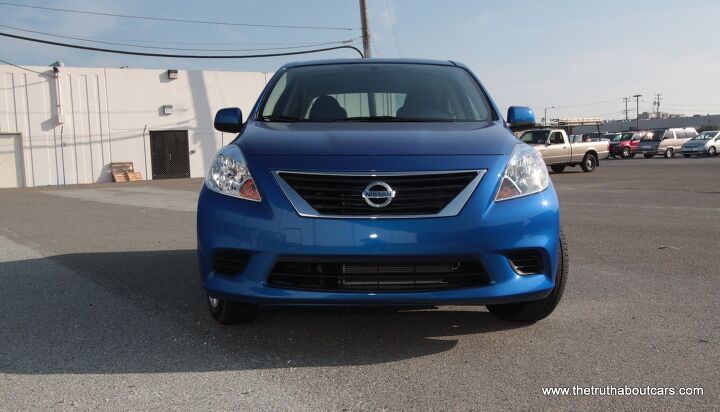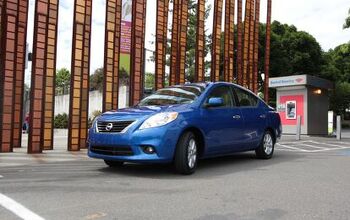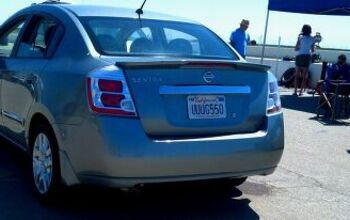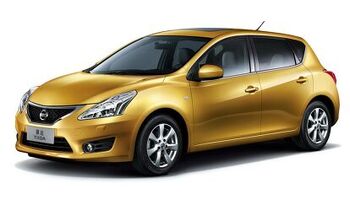Review: 2012 Nissan Versa Vs 2012 Nissan Sentra

Here’s a statement you won’t see at any other automotive outlet – when I hopped out of a 2012 Mercedes CLS and into a 2012 Nissan Versa SL, I felt like I was at home. This has as much to do with my auto journalist salary as it does my love of bargains. As much as I love $50,000 pickups and supercharged sports sedans, my friends and relations rarely ask which AMG product they should buy. Usually, the decision looks a little like the photograph above. Today’s quandary: the 2012 Nissan Versa vs the 2012 Nissan Sentra. Let the games begin.
Compact cars have a wide appeal to many customers, even if they’re not the sexiest choices out there. You might be shopping for a commuter car, or something for your college bound teen. Maybe it’s your first car, or a car for your elderly mother who doesn’t want anything “complicated”. Whatever the reason, when you’re shopping in the sub-$20,000 range, it’s not unreasonable to ask whether the “next size up” is worth the 30 percent premium that often comes with it. With the introduction of the all-new Versa, and the continued production of the venerable Sentra, Nissan has made the conundrum that much harder, with the new Versa continuing the tradition of delivering a large interior for a small price. But does that mean the Sentra is superfluous?
Clad in a sporty red finish, we have the middleweight 2012 Nissan Sentra 2.0S with a base price of $17,990 plus $850 in options, (Bluetooth, keyless go, leather wrapped steering wheel and cargo management in the trunk) and $760 in destination charges landing this competitor just shy of 20-large at $19,870. On the right in blue we have the bantam weight 2012 Versa SV sedan starting at $14,560 plus $520 of options (Bluetooth, iPod interface, map lights vanity mirrors, steering wheel audio controls and floor mats) and the same $760 in destination fees yields a $15,840 MSRP. While it is true you can find a Versa for the $10,990 base price, if you want features the market has come to expect like power windows, power door locks, automatic transmission, and more than two speakers, you have to move up the price ladder. Similarly, the base Sentra for $16,250 comes with a manual and lacks creature comforts the commuter car shopper will want like Bluetooth and a place to plug your iPod in. While our Versa SV tester lacked keyless-go and some price adjustment must be made, the Versa handily wins round 1 with it’s $4,030 smaller MSRP.
Looks are a personal preference, but placed side-by-side, the older design language of the Sentra was immediately obvious. The Versa’s curvaceous new form on the other hand seems less “economy” than the outgoing model and to some, more attractive than the Sentra. Sure, the Versa’s narrow track and tall roofline split my informal polling group between those who found the look strangely proportioned and those that found it strangely cute. Either way that was more emotion than the Sentra managed to evoke.
When shopping for a commuter car, the assumption is you’re going to be spending 30 minutes or more inside the car every day. After all, if you commute is short, why have a dedicated “commuter car?” As such, the feel and creature comforts are more important than styling, and in this fight, the Sentra makes a comeback. The Versa’s interior is designed to be profitable (or at least break even) at its $10,990 base price and it shows. From the lack of a center arm rest up front to the hard plastic trim on the doors, the interior certainly feels less expensive than the Sentra which sports a leather wrapped steering wheel, fabric door trim, a center armrest and plenty of silver plastic trim. While the Versa’s plastics may be low rent, they are no worse than those in the Mazda 2 or the new Chevy Spark and only a notch below the Sentra and Chevy Sonic. If you’re shopping a Versa, do yourself a favor and buy a model with the “sandstone” interior. The resulting two-tone dash makes the interior look far more upmarket than the black-on-black model – check out the gallery in our look at the pre-production model from last July if you don’t believe me. While I found nothing objectionable during my week with the Versa, my one-hour one-way commute did serve to remind me how much I missed having an armrest, a leather wrapped wheel and some cushy fabric on the door. The winner in this round is the Sentra with its higher quality touch points.
While the Sentra’s price buys a more appealing steering wheel and a significantly better headliner (the Versa’s “fabric” is reminiscent of the material GM uses to line trunks), the rest of the cabin materials are no more up-market than the Versa. As a result, the passenger comfort round sees some fierce competition. Rear passengers in the Sentra are treated to a center armrest with integrated cup holders and padded door armrests, but the Versa fights back with nearly four more inches of leg room than the Sentra. As oxymoronic as it may sound, the smallest Nissan still sells on spaciousness. This is a fact I did not fully appreciate until I agreed to take some friends to the airport. The send-off journey in the Sentra was a cramped affair (we are all six-feet tall or over) and the Versa proved more comfortable on the return journey home. The reason is due largely to those 38-inches of rear leg room, not only the most in its class, but more than a Ford Fusion or Honda Accord. It’s worth nothing that the Versa is four-inches narrower than the Sentra, meaning sitting three-abreast in the rear is far from enjoyable. For the young family shopper, the Versa was able to comfortably accommodate two rearward facing child seats and a 6-foot, four-inch tall driver while the Sentra was more of a squeeze. Unless you really need to carry 5 regularly or value armrests over leg room, the Versa wins this round with its rear seat leg room and accommodations for two child seats.
Commuters may not care about cargo capacity that much, but it’s handy to have it when you need it. The young family shopper may find this more important with a need to jam luggage for four in the trunk. On the surface the Sentra’s larger proportions and trunk hinges that don’t impact the cargo area set it up for an easy win, but the plucky Versa manages to best the Sentra by 1.7 cubic feet in the rear. With 14.8 cubic feet available, the Versa’s booty is only 4% smaller than a Dodge Charger’s trunk. Even subtracting the space occupied by the trunk hinges, our “airport shuttling” proved that it was easier to get our friend’s bags in the Versa than the Sentra. If this is your family car, you might not want to take the Versa as the ready winner. The Sentra’s standard folding rear seats make loading IKEA flat-packs possible in the Sentra. The Versa does offer folding rear seats, but only in the more expensive SL trim. With a bigger trunk in the Versa, but no folding seats, our cargo carrying fight ends in a dead heat.
My journey to and from SFO is a 66-mile one way journey which involves going over a fairly windy 2,000-foot mountain pass. With 800-pounds of human cargo and easily 200lbs of luggage in the trunk, both vehicles had their work cut out for them.The Sentra has a respectably low (for a modern car) 3,000lb curb weight when equipped with Nissan’s CVT. To shift this weight, the Sentra is equipped with Nissan’s popular 2.0L four-cylinder engine. For Sentra duty, this variable valve timing engine is worth 140HP and 147lb-ft of torque. The Versa on the other hand weighs 576lbs less than the Sentra. At 2424lbs, the Versa isn’t just light for a four-door sedan, it’s light for our modern era period. The small Nissan is only 300lbs heavier than the microscopic Scion iQ despite having more doors and being four and a half feet longer. The Versa gets an all-new 1.6L mill capable of 109HP and 107lb-ft of twist. This may sound like an unfair fight with the Sentra cranking out 28% more power, but the Versa counters with 24% less weight and a trick two-speed CVT. The new “Xtronic” transmission marries ye-olde CVT with a two-speed planetary gearset giving the Versa’s drivtrain a broader range than the Sentra. This improved range was obvious when trying to maintain highway speeds at an 8-percent grade. While the Sentra has a better power to weight ratio on paper, the revised CVT delivers a sucker-punch, helping the smaller engine reach its optimum range faster and stay there longer. The results are clearly seen in our back-to-back quarter-mile tests. The Sentra ran to 30MPH in 3.35 seconds, 60MPH in 9.09 seconds and finished the quarter-mile in 17.06 seconds at 80MPH. The Versa got a quick start hitting 30MPH in 3.11 seconds. By 60MPH the gap was closing with the Versa essentially neck and neck with the Sentra at 9.04 seconds. Above 60MPH, the two-speed gearset helped the Versa finish the quarter-mile race at 16.97 seconds and 81MPH. (It should be noted this was faster than our pre-production Versa in June by a decent margin due likely to improved tuning of the production drivetrain). If straight line performance is really what you’re after, then neither sedan is likely to get your juices flowing. If you just need to make sure you can get on the freeway without getting out to push, both sedans perform admirably. This fight also ends in a tie.
When the going gets twisty, those interested in performance should cross both sedans off their shopping list. If you want a Nissan compact sedan with decent handling characteristics you should just throw down $20,810 for a Sentra SE-R Spec V and call it a day. If however your primary interest is to not head into the forest at the slightest curve, the Versa with its lower curb weight and 185-width tires delivers a decent balance of road holding and ride characteristics due as much to its weight as its 102.5-inch wheelbase. Contrary to most of the automotive press, I have a peculiar love for the CVT and its passion for letting an engine rev at high RPMs endlessly while climbing a hill. Aside from the novelty, it pays dividends for the consumer in hill climbing performance and fuel economy. The Sentra also performs well and its longer wheelbase does make the ride a hair more composed over washboard pavement. For its overall refinement, the Sentra wins.
Speaking of those elusive MPGs, fuel economy is one of the most important factors for many compact sedan shoppers. If you don’t get twice the MPGs from your commuter car as your SUV or Town Car, why bother? Similarly, if you’re not getting near 40MPG, why not just buy a used Camry? During our 705-miles with the Sentra and 675-miles with the Versa we averaged 31.4MPG and 37.9MPG respectively in similar driving situations. Our numbers are taken from our own fill-up calculations but are fairly close to the car’s trip computer estimates. The interesting take-away for the commuter car shopper is that the Versa’s average fuel economy was far closer to its EPA 2008 highway numbers than the Sentra. If your commute requires a great deal of stop-and-go highway travel, then neither sedan will blow you away and you’d be best served waiting for something like the new Prius C. If however your commute is primarily highway, the Versa wins handily.
While the more expensive Sentra makes several compelling arguments with a few more creature comforts, two more speakers, a much-needed armrest for the driver and a more refined feel, the cost difference of $4000 skews the balance towards the Versa. Adjusting for additional content, the difference lands between $3000 and $3500 depending on which web tool you believe. While adjusted numbers are nice, if you want those basic commuter car features of Bluetooth and multimedia interfaces, then the difference is still about $4000 when it comes time to get that new car loan (less any cash on the hood). I’m not sure if this is a backhanded compliment or not, but the Versa delivers a totally unobjectionable experience at a very compelling price. So if you’re out there shopping Sentra vs Versa, save yourself some cash, get the Versa and take a road trip with the difference.
Nissan provided the cars, insurance and one tank of gas per vehicle for this review.
Specifications as tested
Sentra / Versa
0-30 MPH: 3.35 seconds / 3.11 seconds
0-60 MPH: 9.09 seconds / 9.04 seconds
1/4 mile: 17.06 seconds at 80MPH / 16.97 seconds at 81MPH

More by Alex L. Dykes
Latest Car Reviews
Read moreLatest Product Reviews
Read moreRecent Comments
- Lorenzo I just noticed the 1954 Ford Customline V8 has the same exterior dimensions, but better legroom, shoulder room, hip room, a V8 engine, and a trunk lid. It sold, with Fordomatic, for $21,500, inflation adjusted.
- Lorenzo They won't be sold just in Beverly Hills - there's a Nieman-Marcus in nearly every big city. When they're finally junked, the transfer case will be first to be salvaged, since it'll be unused.
- Ltcmgm78 Just what we need to do: add more EVs that require a charging station! We own a Volt. We charge at home. We bought the Volt off-lease. We're retired and can do all our daily errands without burning any gasoline. For us this works, but we no longer have a work commute.
- Michael S6 Given the choice between the Hornet R/T and the Alfa, I'd pick an Uber.
- Michael S6 Nissan seems to be doing well at the low end of the market with their small cars and cuv. Competitiveness evaporates as you move up to larger size cars and suvs.

















































































































Comments
Join the conversation
2012 Versa incoming = factory flaws. 2012 Sentra outgoing = shanty town Amigo's on hold for 2013. SER spec Sentra with larger four and all wheel discs but no 60/40. 2012 Versa with 2nd gen CVT & interplanetary gears. Not just Nissan the Koreans are beating... Well Nissan what's with 2013 Sentra secrecy?
I drove a 1997 Sentra for 12 years, and this comparison confirms my suspicion that the current Versa bears a much stronger resemblance to that Sentra than it does to the previous generations of Versa. The current Sentra reminds me more of a 1997 Altima with more creased lines in the design, but intended less for midrange families and more for rental fleets. That's not a compliment, Nissan. Also, there's got to be a way to make the interiors look like Nissan spent actual money on them, regardless of actual expenditures.